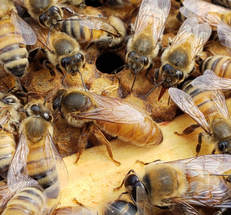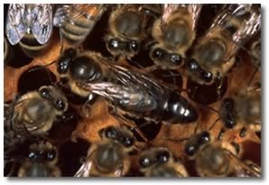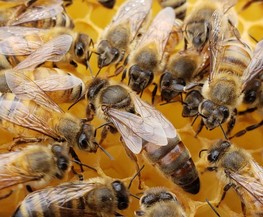Italian
Attractive blonde coloration makes queen locating less difficult. Superb comb builders, honey producers, very gentle and productive. Builds exceptionally fast in early spring.
Carniolan
Chocolate brown to nearly black. Forages on colder and wetter days. Overwinters well on small stores. Explosive buildup in later Spring. Exceptionally gentle and easy to work.
Mite BitersBased on Purdue Ankle Biter stock. Workers remove mites, and mite pups, from under larvae caps. Eliminating mites from the colonies. Breeder Queens are tested 85%+ effective.
Color varies. Russian Queens Not Available
The Russian honeybee originate in the Primorsky Krai region of Russia. They were imported into the United States in 1997 by the USDA’s Honeybee Breeding Program in Baton Rouge, Louisiana.
Russians are naturally very resistant to the Varorra and Tracheal Mite. They are also very productive and extremely winter hardy. Members of the Russian Queen Bee Breeder Association have been working on making Russian bees more gentle. Update July 20, 2022. I will not be offering Russian Queens for sale this year. Though they are a great bee for their productivity, gentleness, production and mite resistance, too many of my colonies failed to thrive their second year and needed to be re queened. I will still breed Russian queens and try to determine why, but at this time they will not be available. Update July 20, 2020. After working with Russians for several months now, I really like these bees! I know the breed comes with a fairly strong stigma of being aggressive, but I just haven't seen it. Like all breeds, they will come out and show aggression under certain circumstances, but readily calm with a lite puff of smoke. They seem a bit "busier" on the comb during inspection, and fly, but they are not focusing on me or trying to sting. Coloration: of the 25 queens purchased, most were dark, but a few very light, like a typical Italian. I chose a very prolific, gentle, dark banded queen as my breeder. Her daughters are all almost clones of her, which shows purity of the breeding stock. Productivity; extremely prolific egg layers. Not unusual for the queen to lay the entire frame from corner to corner. They almost seem to lay out side the cluster and won't be cared for, but I haven't found any dried up eggs yet. Mite Resistance; after several tests (alcohol wash and dissecting drone larvae) mite counts have been extremely low, like non existent. Not jumping to any conclusions on this yet, as all of my bees are pretty miter free at the moment. Please see Queen Introduction page for tips to introduce your queen properly
|


